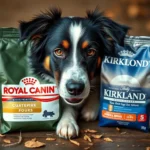
Introduction
Dog nutrition is a critical aspect of pet ownership that often goes overlooked. A balanced diet is essential for dogs to thrive, impacting their health, energy levels, and longevity. For large breed dogs, the stakes are particularly high. These majestic canines have unique nutritional needs that must be met to ensure they lead healthy lives, free from common health issues that can arise from improper feeding.
Large breed dogs tend to face specific challenges, such as joint problems and obesity, which are closely tied to their dietary habits. Therefore, understanding their nutritional requirements is crucial. This article aims to provide insights into affordable yet quality dog food options tailored for large breeds, emphasizing the importance of making informed choices without breaking the bank.
Understanding Large Breed Nutrition
Nutritional Requirements for Large Breeds
When it comes to best inexpensive dog foods for large breeds, knowing what makes up a balanced diet is essential. Large breed dogs require a specific ratio of macronutrients and micronutrients to support their growth and overall health.
Macronutrients: Proteins, Fats, and Carbohydrates
- Proteins: Protein is vital for maintaining muscle mass and supporting overall growth. Large breed puppies, in particular, need a protein-rich diet to develop strong muscles and healthy tissues.
- Fats: Healthy fats provide energy and contribute to skin and coat health. Omega fatty acids, like omega-3 and omega-6, are especially important for reducing inflammation and promoting joint health.
- Carbohydrates: While dogs can derive energy from fats and proteins, carbohydrates play a crucial role in digestive health. High-quality grains and vegetables can be excellent sources of fiber.
Vitamins and Minerals
Large breed dogs also need specific vitamins and minerals for optimal health. Key nutrients include:
- Calcium and Phosphorus: These minerals are essential for bone health and growth, especially in puppies.
- Omega Fatty Acids: These support skin, coat, and joint health, protecting against common ailments in large breeds.
Common Health Issues in Large Breeds
Large breed dogs are susceptible to several health issues, many of which are influenced by their diet.
Joint Health Concerns
Joint problems, such as hip dysplasia and arthritis, are prevalent in large breeds. A nutritious diet that includes joint-supporting supplements, like glucosamine and chondroitin, can help mitigate these risks. Additionally, maintaining a healthy weight through proper nutrition can alleviate stress on their joints.
Obesity Risks
While large breeds require more calories than smaller dogs, overfeeding can lead to obesity, which exacerbates joint problems and other health issues. It’s crucial to monitor their weight and adjust their food intake accordingly to ensure a healthy body condition.
Identifying Quality Dog Food
Reading Dog Food Labels
When searching for the best inexpensive dog foods for large breeds, understanding how to read dog food labels is essential.
Understanding Ingredients
Look for high-quality protein sources as the first ingredient. Avoid foods that list fillers or by-products, which offer little nutritional value. Whole ingredients, such as chicken, beef, fish, and vegetables, are preferable.
Nutritional Analysis
Review the guaranteed analysis on the label, which outlines the nutritional content. Ensure that the food meets AAFCO standards, indicating it provides complete and balanced nutrition.
Evaluating Brand Reputation
Researching dog food brands is crucial in selecting quality products.
Researching Brands
Check for company transparency regarding ingredient sourcing and recalls. Brands with a history of transparency are more likely to produce reliable products.
Certifications and Testing
Look for certifications from organizations like the National Animal Supplement Council (NASC), which signify adherence to quality and safety standards.
Best Inexpensive Dog Foods for Large Breeds
Top Affordable Brands
Here are some of the best inexpensive dog foods for large breeds that provide quality nutrition without breaking the bank.
Brand 1: Purina Pro Plan Large Breed
- Overview: Purina Pro Plan offers a range of large breed formulas designed for the specific nutritional needs of these dogs.
- Key Features: High-quality protein sources, balanced fats, and essential vitamins and minerals.
- Price Point: Approximately $50 for a 30-pound bag.
Brand 2: Blue Buffalo Life Protection Formula Large Breed
- Overview: Known for using high-quality natural ingredients, Blue Buffalo is a popular choice among dog owners.
- Key Features: Real meat is the first ingredient, and it contains LifeSource Bits, a blend of antioxidants, vitamins, and minerals.
- Price Point: Around $60 for a 30-pound bag.
Brand 3: Hill’s Science Diet Large Breed
- Overview: Hill’s Science Diet is formulated by veterinarians and focuses on the nutritional needs of large breeds.
- Key Features: High protein for lean muscle maintenance, and balanced minerals for healthy bones and joints.
- Price Point: Approximately $55 for a 30-pound bag.
Brand 4: Iams ProActive Health Large Breed
- Overview: Iams is designed to meet the needs of large breed dogs with its focus on high-quality protein and essential nutrients.
- Key Features: Real chicken as the first ingredient, and tailored fiber blend for healthy digestion.
- Price Point: About $45 for a 30-pound bag.
Brand 5: Rachael Ray Nutrish Large Breed
- Overview: This brand offers a more budget-friendly option without compromising on quality.
- Key Features: Real meat, wholesome veggies, and no artificial preservatives.
- Price Point: Approximately $40 for a 28-pound bag.
Comparison of Nutritional Value
To make an informed choice among the best inexpensive dog foods for large breeds, here’s a comparison of key nutritional aspects:
| Brand | Protein (%) | Fat (%) | Fiber (%) | Calories (per cup) |
|---|---|---|---|---|
| Purina Pro Plan | 26 | 12 | 4 | 370 |
| Blue Buffalo | 24 | 14 | 5 | 396 |
| Hill’s Science Diet | 24 | 14 | 4 | 352 |
| Iams ProActive Health | 26 | 14 | 4 | 374 |
| Rachael Ray Nutrish | 24 | 10 | 4 | 358 |
Value for Money Analysis
While price is an important factor, the nutritional quality should also be considered. Brands like Purina Pro Plan and Iams offer excellent protein and fat balance at a lower cost per serving compared to premium brands like Blue Buffalo. Evaluating the cost per serving against nutritional quality can help you find the best value for your large breed dog.
Homemade vs. Store-Bought Dog Food
Pros and Cons of Homemade Dog Food
Homemade dog food can be a tempting option for pet owners looking to control their dog’s diet.
Benefits of Homemade Diets
- Control over Ingredients: You can choose high-quality sources and avoid fillers and preservatives.
- Customization: Tailor the diet to meet your dog’s specific needs, especially if they have allergies or sensitivities.
Drawbacks of Homemade Diets
- Time-Consuming: Preparing homemade meals requires time and effort.
- Nutritional Imbalances: Without proper knowledge, it’s easy to create an unbalanced diet, leading to health issues over time.
When to Choose Store-Bought
Store-bought dog food offers convenience and consistency, making it a practical choice for many pet owners.
- Balanced Nutrition: Commercial dog foods are formulated to meet AAFCO standards, ensuring they provide complete nutrition.
- Reliability: With store-bought options, you can trust that the formula is consistent, unlike homemade diets which might vary in nutritional content.
Tips for Transitioning to New Dog Food
Gradual Transition Process
When switching to a new dog food, a gradual transition is crucial to avoid gastrointestinal upset.
Importance of Gradual Change
A sudden change in diet can lead to digestive issues like diarrhea or vomiting. Gradually introducing the new food allows your dog’s digestive system to adjust.
Timeline for Transition
A recommended timeline for transition is 7-10 days. Start by mixing a small amount of the new food with the current food, gradually increasing the new food’s proportion.
Monitoring Your Dog’s Reaction
After transitioning to a new diet, monitor your dog for any signs of allergies or intolerances.
Signs of Allergies or Intolerance
Common symptoms include itching, gastrointestinal upset, or changes in behavior. If you notice any of these signs, consult with your veterinarian.
Consulting a Veterinarian
Professional guidance can help ensure that your dog’s dietary needs are being met and that any potential issues are addressed promptly.
Conclusion
Proper nutrition is vital for the health and well-being of large breed dogs, and it’s possible to provide them with quality food at an affordable price. By understanding their unique nutritional needs, evaluating food labels, and selecting reputable brands, you can make informed choices that benefit your furry friend. Remember, the best inexpensive dog foods for large breeds should not compromise on quality, as a healthy diet ultimately leads to a happier, longer life for your beloved pet.









